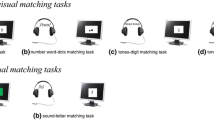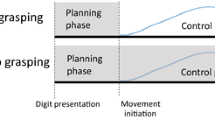Abstract
The interaction between numbers and action-related process has received increasing attention in the literature of numerical cognition. In the current study, two dual-task experiments were conducted to explore the interaction among numerical, prehension, and perceptual color/size judgments. The results revealed the commonality and distinctness of the magnitude representations that are involved in these tasks. Specifically, a photograph of a graspable object with a superimposed Arabic digit was presented in each trial. Participants were required to first judge the parity of the digit with a manual response while simultaneously planning a subsequent vocal response pertaining to the depicted object. When parity and action judgments were performed close in time, the compatibility effect between the numerical magnitude of the digit and the appropriate action (pinch vs. clutch) for the object was demonstrated in both manual and vocal responses. In contrast, such compatibility effect was absent when parity judgment was coupled with color-related or perceptual size judgment. The findings of the current study support the existence of a common magnitude code underlying numerical and non-numerical dimensions for action-related purposes, as proposed by the ATOM model (Walsh in Trends Cogn Sci 7:483–488, 2003). Furthermore, based on the selective presence of the compatibility effect, we argue that the interaction among different quantity dimensions conforms to the “dorsal-action and ventral-perception” organizational principle of the human brain.




Similar content being viewed by others
Notes
In fact, when we defined the vocal RT as the interval between the stimulus onset and the vocal response, we obtained similar results to those reported in the present study. However, when the vocal RTs were computed from the stimulus onset, they would inevitably include the duration of the manual RTs. As a result, even if we observed the compatibility effect in the vocal responses, it is not clear whether the effect is contaminated by the compatibility effect in the manual responses. In order to evaluate the compatibility effect in the vocal and manual responses independently, we chose to report the vocal RTs that were measured from the onset of manual responses.
A within-participant ANOVA on error rates, similar to the one conduced on RT data, revealed no significant main effects or interactions, all Ps > 0.16. To examine whether there was a SNARC effect, we also submitted the RT data into a mixed-design ANOVA with finger (index vs. middle) and number (small vs. large) as two within-participant factors, and rule (odd-index/even-middle vs. odd-middle/even-index) as a between-participant factor. The results only revealed the main effects of finger, F(1, 22) = 10.0, P < 0.01, and number, F(1, 22) = 18.4, P < 0.001, while the finger × number interaction (i.e., the SNARC effect) was not significant, F(1, 22) = 1.3, P > 0.26. The lack of the SNARC effect might be due to the close distance, hence small spatial displacement, between the two buttons for manual responses.
A similar analysis of error rates only revealed a significant main effect of number magnitude, F(1, 23) = 5.1, P < 0.05. Responses to large numbers (11%) were more error prone than responses to small numbers (9.3%). All other main effects and interactions were not significant (all Ps > 0.11). Similar to Experiment 1, in the analysis of the SNARC effect, we only detected the main effect of number, F(1, 22) = 31.4, P < 0.001, and the interaction between finger and rule, F(1, 22) = 14.7, P < 0.01. The finger × rule interaction actually reflected a parity effect, namely, RTs to odd numbers were slower than those to even numbers in both finger-to-parity assignments (both Ps < 0.05).
In this analysis, we also observed a significant main effect of object type, F(1, 23) = 41.3, P < 0.001. The RTs of uttering “nie” (pinch; 516 ms) to a strawberry was slower than those of uttering “zhua” (clutch; 471 ms) to a guava (see Fig. 4). Such an effect merely indicated the difference in voice onset time, i.e., the nasal sound “nie” took more time to pronounce than the fricative sound “zhua”.
References
Andres M, Davare M, Pesenti M, Olivier E, Seron X (2004) Number magnitude and grip aperture interaction. Neuroreport 15:2773–2777
Andres M, Ostry DJ, Nicol F, Paus T (2008) Time course of number magnitude interference during grasping. Cortex 44:414–419
Badets A, Andres M, Di Luca S, Pesenti M (2007) Number magnitude potentiates action judgments. Exp Brain Res 180:525–534
Brannon EM (2006) The representation of numerical magnitude. Curr Opin Neurobiol 16(2):222–229
Caessens B, Hommel B, Reynvoet B, van der Goten K (2004) Backward-compatibility effects with irrelevant stimulus–response overlap: the case of the SNARC effect. J Gen Psychol 13:411–425
Canessa N, Borgo F, Cappa SF, Perani D, Falini A, Buccino G, Tettamanti M, Shallice T (2007) The different neural correlates of action and functional knowledge in semantic memory: an event-related fMRI study. Cereb Cortex 18(4):740–751
Cavina-Pratesi C, Goodale MA, Culham JC (2007) fMRI reveals a dissociation between grasping and perceiving the size of real 3D objects. PLoS ONE 2(5):e424. doi:10.1371
Cohen Kadosh R, Henik A, Rubintsen O, Mohr H, Dori H, van de Ven V, Zorzi M, Hendler T, Goebel R, Linden DEJ (2005) Are numbers special? The comparison systems of the human brain investigated by fMRI. Neuropsychologia 43:1238–1248
Cohen Kadosh R, Cohen Kadosh K, Linden DEJ, Gevers W, Berger A, Henik A (2007) The brain locus of interaction between number and size: a combined functional magnetic resonance imaging and event-related potential study. J Cogn Neurosci 19:957–997
Culham JC, Danckert SL, DeSouza JF, Gati JS, Menon RS, Goodale MA (2003) Visually guided grasping produces fMRI activation in dorsal but not ventral stream brain areas. Exp Brain Res 153:180–189
Dormal V, Seron X, Pesenti M (2006) Numerosity-duration interference: a Stroop experiment. Acta Psychol 121(2):109–124
Fias W, Lauwereyns J, Lammertyn J (2001) Irrelevant digits affect feature-based attention depending on the overlap of neural circuits. Cogn Brain Res 12:415–423
Fias W, Dupont P, Reynvoet B, Orban GA (2002) The Quantitative nature of a visual task differentiates between ventral and dorsal stream. J Cogn Neurosci 14(4):646–658
Fias W, Lammertyn J, Reynvoet B, Dupont P, Orban GA (2003) Parietal representation of symbolic and nonsymbolic magnitude. J Cogn Neurosci 15:1–11
Fischer MH, Castel AD, Dodd MD, Pratt J (2003) Perceiving numbers causes spatial shifts of attention. Nat Neurosci 6:555–556
Hommel B (1998) Automatic stimulus-response translation in dual-task performance. J Exp Psychol Hum Percept Perform 24:1368–1384
Kellenbach ML, Brett M, Patterson K (2003) The importance of manipulability and action in tool representation. J Cogn Neurosci 15:30–46
Koch I, Prinz W (2005) Response preparation and code overlap in dual tasks. Mem Cogn 33:1085–1095
Koch I, Rumiati RI (2006) Task-set inertia and memory-consolidation bottleneck in dual tasks. Psychol Res 70:448–458
Lammertyn J, Fias W, Lauwereyns J (2002) Semantic influences on featurebased attention due to overlap of neural circuits. Cortex 38:878–882
Lindemann O, Abola JM, Girardi G, Bekkering H (2007) Getting a grip on numbers: numerical magnitude priming in object grasping. J Exp Psychol Hum Percept Perform 33:1400–1409
Milner AD, Goodale MA (1995) The visual brain in action. Oxford University Press
Oliver RT, Thompson-Schill SL (2003) Dorsal stream activation during the retrieval of object size and shape. Cogn Affect Behav Neurosci 3:309–322
Pinel P, Piazza M, Le Bihan D, Dehaene S (2004) Distributed and overlapping cerebral representations of number, size and luminance during comparative judgments. Neuron 41:983–993
Proctor RW, Cho YS (2006) Polarity correspondence: a general principle for performance of speeded binary classification tasks. Psychol Bull 132:416–442
Rusconi E, Kwan B, Giordano BL, Umiltà C, Butterworth B (2006) Spatial representation of pitch height: the SMARC effect. Cognition 99:113–129
Schwarz W, Ischebeck A (2003) On the relative speed account of number–size interference in comparative judgments of numerals. J Exp Psychol Hum Percept Perform 29:507–522
Stoianov I, Kramer P, Umiltà C, Zorzi M (2007) Visuospatial priming of the mental number line. Cognition 106:770–779
Valyear KF, Cavina-Pratesi C, Stiglick AJ, Culham JC (2007) Does tool-related fMRI activity in intraparietal cortex reflect the plan to grasp? Neuroimage 36:94–108
Walsh V (2003) A theory of magnitude: common cortical metrics of time, space and quantity. Trends Cogn Sci 7:483–488
Wenke D, Frensch PA (2005) The influence of task instruction on action coding: constraint setting or direct coding. J Exp Psychol Hum Percept Perform 31:803–819
Zeki S, Aglioti S, McKeefry D, Berlucchi G (1999) The neurological basis of conscious color perception in a blind patient. Proc Natl Acad Sci USA 96:14124–14129
Author information
Authors and Affiliations
Corresponding author
Rights and permissions
About this article
Cite this article
Chiou, R.YC., Chang, E.C., Tzeng, O.JL. et al. The common magnitude code underlying numerical and size processing for action but not for perception. Exp Brain Res 194, 553–562 (2009). https://doi.org/10.1007/s00221-009-1730-8
Received:
Accepted:
Published:
Issue Date:
DOI: https://doi.org/10.1007/s00221-009-1730-8




